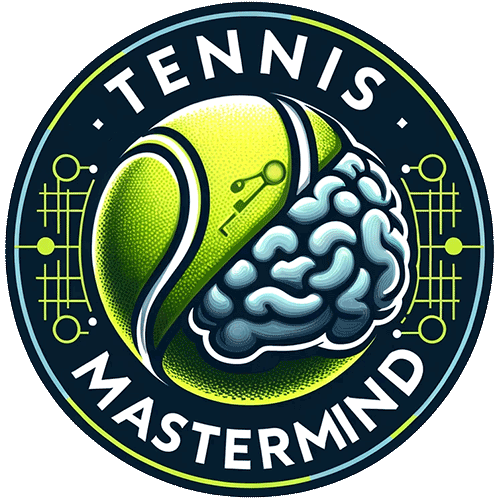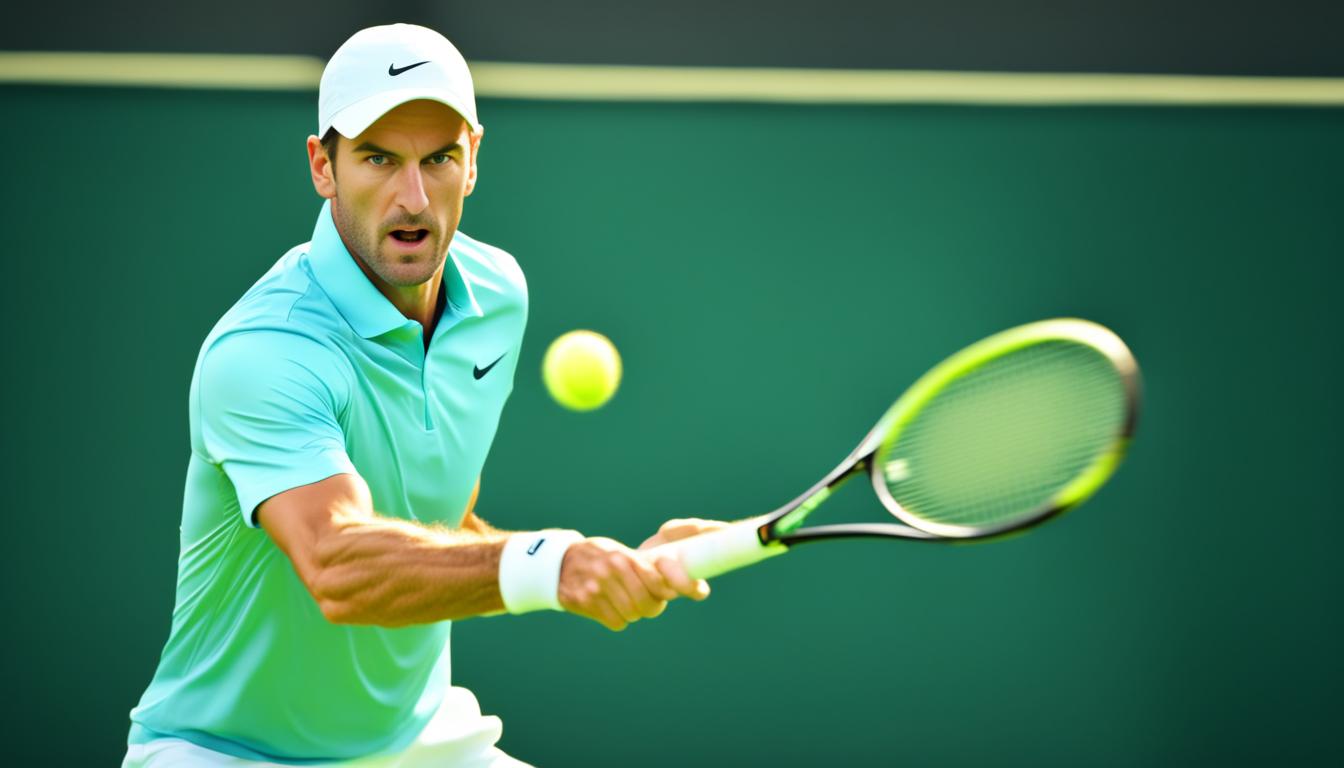Welcome to our guide on building a consistent tennis game. Whether you’re a beginner or an experienced player, developing consistency in your game is essential for improved performance on the court. In this article, we’ll provide you with tips and techniques to help you enhance your tennis skills, master your swing, and achieve greater consistency in your gameplay.
In tennis, consistency is the key to success. It’s not just about hitting the ball hard, but about having smooth and fluid strokes that enable you to maintain control and accuracy in your shots. Professional players achieve this by combining practice, proper technique, and mental focus. By following their footsteps and incorporating their strategies into your training routine, you can elevate your game to the next level.
Key Takeaways:
- Consistency is crucial for improved performance in tennis.
- Smooth and fluid strokes lead to better control and accuracy.
- Practice, technique, and mental focus are key to building a consistent game.
- Learn from professional players and incorporate their strategies into your training routine.
- Consistency in tennis requires dedication and perseverance.
The Basics of a Good Serve
A good serve is crucial in the game of tennis, as it allows players to win points and take control of the match. To develop a consistent and effective serve, three key elements must be mastered: the grip, the stance, and the swing technique.
The Grip: How the player holds the racket is determined by the grip. The Eastern grip is the most common and widely used for its consistency. It provides players with greater control and allows for various types of serves.
The Stance: The stance refers to the positioning of the feet and body before executing the serve. It involves spreading the feet shoulder-width apart, having the non-kicking foot forward, and aligning the body correctly. This stance provides stability and balance, enabling players to generate power and accuracy in their serves.
The Swing Technique: The swing technique is the motion used to hit the ball during a serve. It starts with the racket held behind the head and involves using the body’s weight to generate power. A smooth and fluid swing, combined with the correct timing, allows players to maximize their serve’s power and accuracy.
Mastery of these basics is essential for developing a consistent serve in tennis. By focusing on the grip, the stance, and the swing technique, players can enhance their serving skills and gain a competitive edge on the court.
Breaking Down the Serve into Its Components
A consistent serve is achieved by understanding and practicing its components: the toss, the stroke, and the follow-through.
- The Toss: The toss refers to the precise and consistent placement of the ball when serving. Proper technique and precision in the toss contribute to a reliable serve.
- The Stroke: The stroke involves the swinging motion that begins with the weight shift and ends with the contact between the racket and the ball. It is crucial to maintain a smooth and fluid motion throughout the stroke to achieve serving consistency.
- The Follow-through: The follow-through is the continuation of the swing after the ball is hit. It plays an important role in maintaining balance and alignment. A proper follow-through ensures a consistent and controlled serve.
We must break down the serve into these components and focus on mastering each one to develop a consistent serve. By understanding the importance of a precise toss, a fluid stroke, and a balanced follow-through, players can elevate their serving consistency and improve their overall game.

To further illustrate the significance of these components, let’s take a closer look at each one:
Toss
The toss is the starting point of a successful serve. It requires precision and consistency to position the ball in the desired location. By practicing and refining the toss technique, players can ensure that the ball is consistently placed in the ideal spot for the perfect serve.
Stroke
The stroke is the key action of the serve, where the player swings the racket and makes contact with the ball. A smooth and fluid motion is essential to generate power and achieve accuracy. By focusing on a controlled weight shift and maintaining a relaxed grip, players can improve the consistency of their stroke and optimize their serving performance.
Follow-through
The follow-through is the completion of the swing after the ball has been hit. It involves maintaining balance, alignment, and control. By allowing the racket to naturally flow through the swing and following through with a relaxed and controlled motion, players can enhance their serving consistency and avoid any unnecessary tension or errors.
| Importance | Techniques | |
|---|---|---|
| Toss | Positioning the ball accurately | Practice precision and consistency |
| Stroke | Generating power and accuracy | Focusing on a smooth and fluid motion |
| Follow-through | Maintaining balance and control | Allowing for a relaxed and controlled motion |
By incorporating these components into their practice routine and giving each one the attention it deserves, players can develop a consistent serve that serves as a strong foundation for their overall game.
Technique Tips for Developing a Consistent Serve
Developing a consistent serve requires attention to technique. By focusing on the fundamentals, players can improve their serve and achieve greater consistency on the court. Let’s explore some key tips to enhance your serve:
1. Continental Grip
Using a continental grip provides greater control and versatility in your serve. This grip allows you to adjust the angle of the racket face easily, enabling you to hit different types of serves with more accuracy. Experiment with different grip positions and find the one that feels most comfortable and natural to you.
2. Toss Consistency
Consistency in your toss is crucial for achieving an accurate serve. Practice tossing the ball in the same spot every time, ensuring a consistent height and placement. This will help you maintain control over your serve and set yourself up for a more reliable shot.
3. Smooth Motion
Aim for a smooth and fluid motion in your serve. Avoid jerky movements or rushing through the swing. Instead, focus on a gradual increase in speed while maintaining a relaxed and tension-free stroke. This will improve the overall rhythm and consistency of your serve.
4. Generate Power
Utilize your body weight to generate power in your serve. Shift your weight from the back foot to the front foot as you swing, transferring the energy into the shot. Additionally, keeping your elbow in and close to your body throughout the swing will maximize power and control.
5. Elbow Position
Pay attention to your elbow position during the serve. Keeping your elbow up and aligned with the shoulder will help you maintain a consistent and efficient swing. Avoid letting your elbow drop, as it can lead to misalignment and decreased power.
6. Body Weight
Properly utilizing your body weight is essential for a powerful and consistent serve. Engage your core and drive through the shot with your legs and hips. This will not only generate more power but also provide better stability and control.
“A consistent serve requires mastering the technique and fundamentals. By focusing on the continental grip, toss consistency, maintaining a smooth motion, generating power through body weight, and maintaining proper elbow position, players can develop a more consistent and effective serve.”
By incorporating these technique tips into your practice sessions, you can enhance your serve and elevate your overall performance on the court. Remember, consistency comes with dedication and practice!
Troubleshooting Common Serve Problems
When it comes to serving in tennis, players often encounter common problems that affect their consistency on the court. By addressing these issues through troubleshooting, you can improve your serve and become a more effective player. Let’s take a look at some of the key areas to focus on:
- Adjusting the toss: The accuracy of your serve greatly depends on the height and consistency of your toss. Experiment with different heights and make adjustments to ensure you have optimal control over your serve.
- Stance and posture: Maintaining proper stance and posture throughout your serve is crucial for balance and control. Pay attention to your foot positioning, body alignment, and the angle of your torso to achieve better stability.
- Breaking down the swing: To refine your serve technique, it’s helpful to break down the swing into its individual elements and practice them separately. This allows you to focus on specific areas that may need improvement, such as the backswing, follow-through, or racket path.
- Using body weight: Generating power and consistency in your serve requires efficient use of your body weight. Concentrate on utilizing your lower body and core muscles to transfer energy and generate more force behind your shots.
- Serving strategically: Don’t underestimate the power of strategic serving. Analyze your opponent’s weaknesses and tailor your serves accordingly. Introduce variations, such as spin, placement, or speed, to keep your opponents guessing and gain an advantage on the court.
By tackling these common serve problems and implementing the necessary adjustments, you can improve your serving consistency and elevate your overall game. Stay patient, keep practicing, and remember that a consistent and effective serve takes time and dedication to master.

Quote:
“Addressing common serve problems through troubleshooting helps players improve their serving consistency and take their game to the next level.” – Tennis Pro
Conclusion
Building a consistent tennis game requires mastering the fundamentals and practicing with dedication. Whether it’s developing smooth strokes or honing a reliable serve, consistency is the key to improving performance on the court. By focusing on technique, troubleshooting common problems, and practicing consistently, we can elevate our overall game and achieve greater consistency in our play.
Practicing with dedication is essential to seeing performance improvement. By dedicating ourselves to regular practice sessions, we can develop muscle memory and improve our execution of fundamental tennis skills. Consistency in practice helps us refine our technique and build confidence in our abilities.
Building a consistent serve is particularly important in tennis. By mastering the components of the serve and paying attention to technique, we can achieve a reliable and effective serve that will contribute to our overall performance. With practice and dedication, we can develop the control, power, and consistency necessary to dominate the game.




